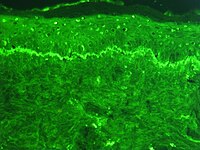User:Iannellog/Example/IIF


Immunofluorescence is the labeling of antibodies or antigens with fluorescent dyes. This technique is often used to visualize subcellular distribution of biomolecules of interest. Immunofluorescent-labelled tissue sections are studied using a fluorescence microscope or by confocal microscopy.
Most commonly, immunofluorescence employs two sets of antibodies: a primary antibody is used against the antigen of interest; a subsequent, secondary, dye-coupled antibody is introduced that recognizes the primary antibody. In this fashion the researcher may create several primary antibodies that recognize various antigens, but, because they all share a common constant region, may be recognized by a single dye-coupled antibody. Typically this is done by using antibodies made in different species. For example, a researcher might create antibodies in a goat that recognize several antigens, and then employ dye-coupled rabbit antibodies that recognize the goat antibody constant region (denoted rabbit anti-goat). This allows re-use of the difficult-to-make dye-coupled antibodies in multiple experiments.
When a secondary antibody labeled with fluorochrome is used to recognize a primary antibody the staining method is called Indirect Immunofluorescence (IIF). Indirect immunofluorescence remains the recommended method for Antinuclear autoantibody (ANA) testing, and it’s considered a powerful, sensitive, and comprehensive test for screening autoantibodies and is still the most used screening assay[1].
The relevance of IIF is emphasized by the increase in the incidence of autoimmune diseases observed over the last years, partly attributable to improved diagnostic capabilities, and to the growing awareness of this clinical problem in general medicine. The major disadvantages of IIF method are the lack of resources and adequately trained personnel; the low level of standardization [2]; the photobleatching effect [3]; interobserver variability which limits the reproducibility of IIF readings [4]; the lack of automatized procedures. To date, the highest level of automation in IIF tests is the preparation of slides with robotic devices performing dilution, dispensation and washing operations. Although this greatly helps in speeding up the routine part of the tests and in improving the standardization level, it does not affect most of the above problems. These observations suggest that the use of digital images[5] and the development of a Computer-aided diagnosis (CAD) system supporting the IIF diagnostic procedure would be beneficial in many respects.
In some cases, it is advantageous to use primary antibodies directly labelled with a fluorophore. This direct labelling decreases the number of steps in the staining procedure and, more importantly, often avoids cross-reactivity and high background problems. Fluorescent labelling can be performed in less than one hour with readily available labeling kits.
As with most fluorescence techniques, a significant problem with immunofluorescence is photobleaching. Loss of activity caused by photobleaching can be controlled by reducing the intensity or time-span of light exposure, by increasing the concentration of fluorophores, or by employing more robust fluorophores that are less prone to bleaching (e.g. Alexa Fluors or DyLight Fluors).
Many uses of immunofluorescence have been outmoded by the development of recombinant proteins containing fluorescent protein domains, e.g. green fluorescent protein (GFP). Use of such "tagged" proteins allows much better localization and less disruption of protein function.
References[edit]
- ^ Kavanaugh A, Tomar R, Reveille J, Solomon DH, Homburger HA. Guidelines for clinical use of the antinuclear antibody test and tests for specific autoantibodies to nuclear antigens. Archives of Pathology and Laboratory Medicine 2000; 124: pp. 71-81.
- ^ Pham B.N., Albarede S., Maisonneuve P., Impact of external quality assessment on antinuclear antibody detection performance, Lupus 2005; 14: 113-119.
- ^ Song L, Hennink EJ, Young IT, Tanke HJ. Photobleaching kinetics of fluorescein in quantitative fluorescence microscopy. Biophysical Journal 1995; 68: 2588-2600.
- ^ Bizzaro N, Tozzoli R, Tonutti E, Piazza A, Manoni F, Ghirardello A, Bassetti D, Villalta D, et al. Variability between methods to determine ANA, anti-dsDNA and anti-ENA autoantibodies: a collaborative study with the biomedical industry. Journal of Immunological methods 1998; 219: 99-107.
- ^ Rigon A., Soda P., Zennaro D., Iannello G., Afeltra A., 'Indirect immunofluorescence (IIF) in autoimmune diseases: Assessment of digital images for diagnostic purposes', Cytometry Part B: Clinical Cytometry, vol. 72B, no. 6, pp. 472-477, June 2007.
External links[edit]
- Images associated with autoimmune diseases at University of Birmingham
- Immunofluorescence protocol and confocal microscopy resources at confocal-microscopy.org
- Overview at Davidson College
- Immunofluorescence Staining Protocol
- Immunofluorescence at the U.S. National Library of Medicine Medical Subject Headings (MeSH)
- Computer Aided Diagnosis of Fluorescence Intensity in IIF tests at Università Campus Bio-Medico di Roma
